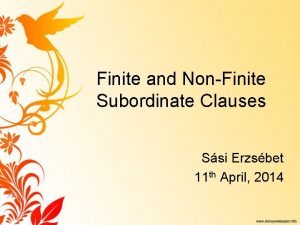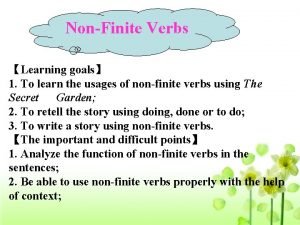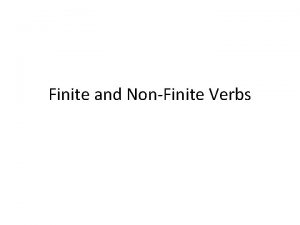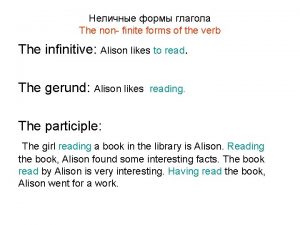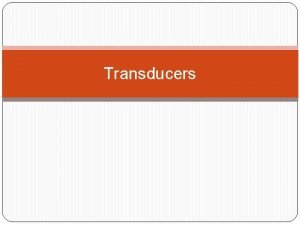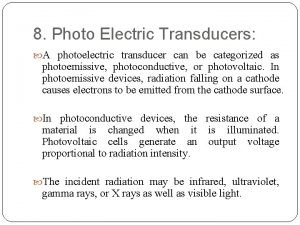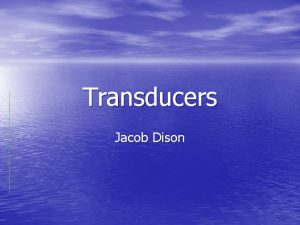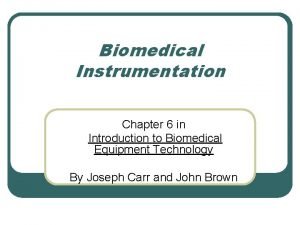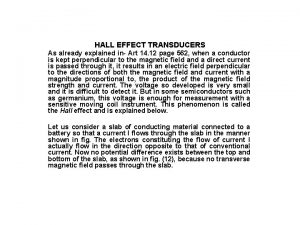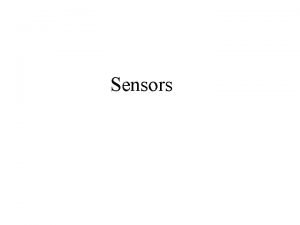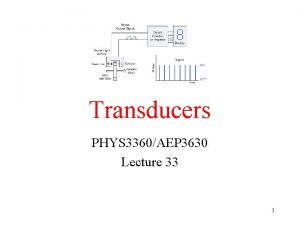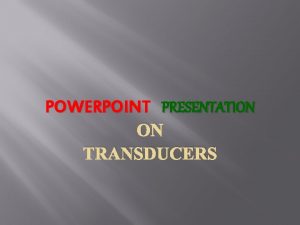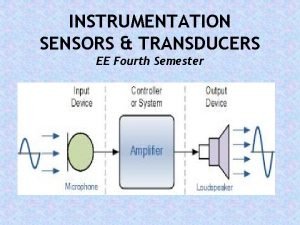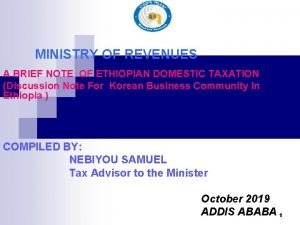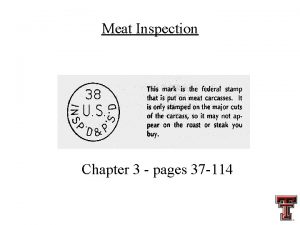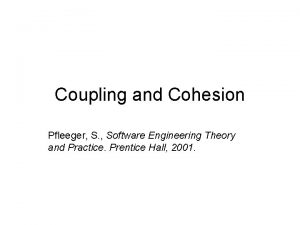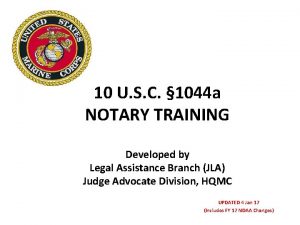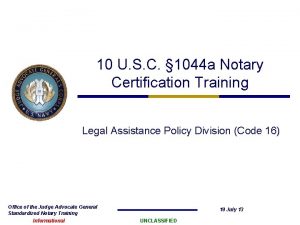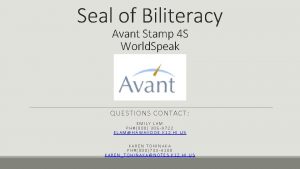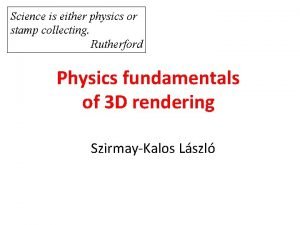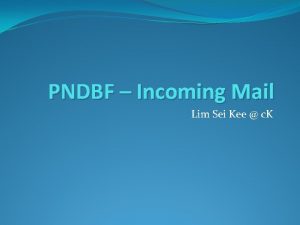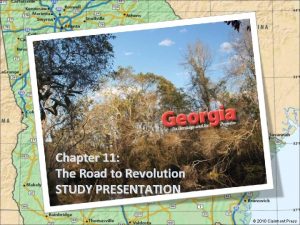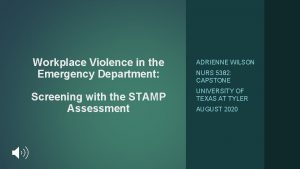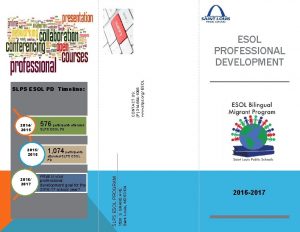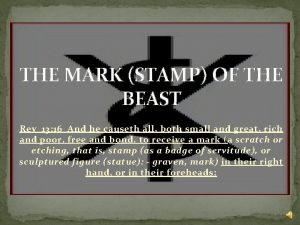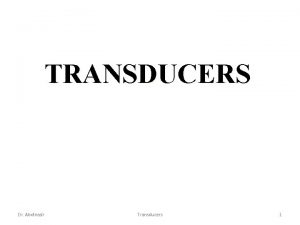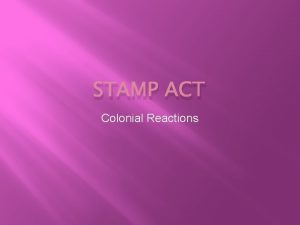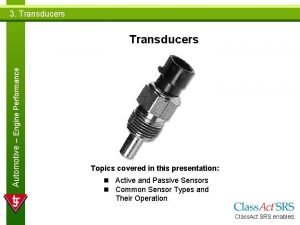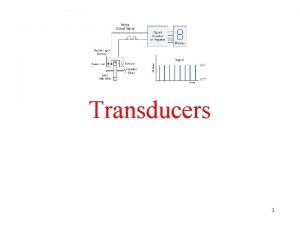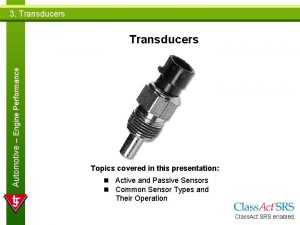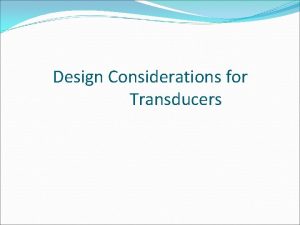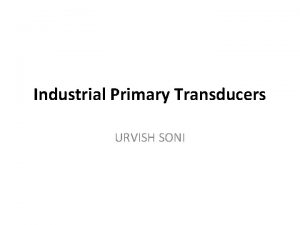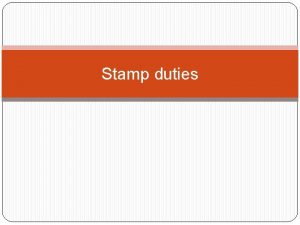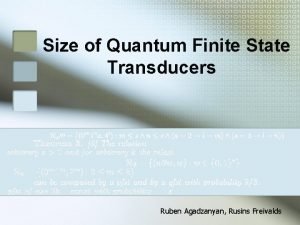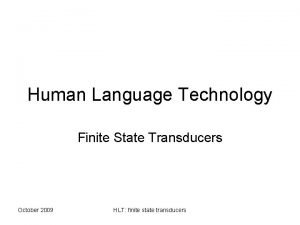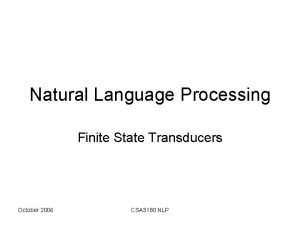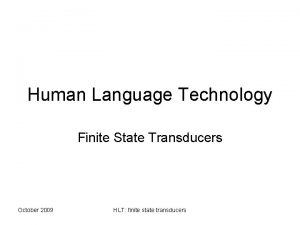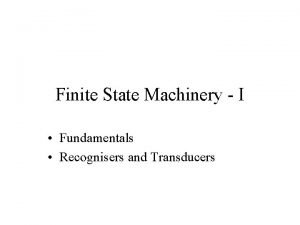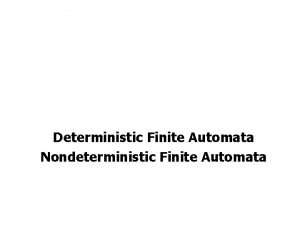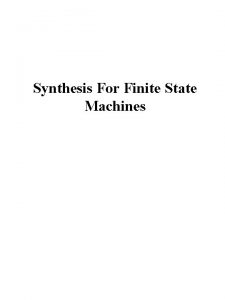Finite State Transducers Mark Stamp Finite State Transducers








































- Slides: 40

Finite State Transducers Mark Stamp Finite State Transducers 1

Finite State Automata q FSA states and transitions o Represented as labeled directed graphs o FSA has one label per edge q State are circles: o Double circles for end states: q Beginning state o Denoted by arrowhead: o Or, sometimes bold circle is used: Finite State Transducers 2

FSA Example q Nodes are states q Transitions are (labeled) arrows q For example… a c 1 z Finite State Transducers 2 3 y 3

Finite State Transducer q FST input & output labels on edge o That is, 2 labels per edge o Can be more labels (e. g. , edge weights) o Recall, FSA has one label per edge q FST represented as directed graph o And same symbols used as for FSA o FSTs may be useful in malware analysis… Finite State Transducers 4

Finite State Transducer q FST has input and output “tapes” o Transducer, i. e. , can map input to output o Often viewed as “translating” machine o But somewhat more general q FST is a finite automata with output o Usual finite automata only has input o Used in natural language processing (NLP) o Also used in many other applications Finite State Transducers 5

FST Graphically q Edges/transitions are (labeled) arrows o Of the form, i : o, that is, input: ouput q Nodes labeled numerically q For example… a: b c: d 1 z: x Finite State Transducers 2 3 y: q 6

FST Modes q As previously mentioned, FST usually viewed as translating machine q But FST can operate in several modes o Generation o Recognition o Translation (left-to-right or right-to-left) q Examples Finite State Transducers of modes considered next… 7

FST Modes a: b q Consider this simple example: q Generation mode 1 o Write equal number of a and b to first and second tape, respectively q Recognition mode o “Accept” when 1 st tape has same number of a as 2 nd tape has b q Translation Finite State Transducers mode next slide 8

FST Modes q Consider this simple example: q Translation mode a: b 1 o Left-to-right For every a read from 1 st tape, write b to 2 nd tape o Right-to-left For every b read from 2 nd tape, write a to 1 st tape q Translation is the mode we usually want to consider Finite State Transducers 9

WFST q WFST == Weighted FST o Include a “weight” on each edge o That is, edges of the form i : o / w q Often, probabilities serve as weights… a: b/1 1 z: x/0. 4 Finite State Transducers c: d/0. 6 2 3 y: q/1 10

FST Example q Homework… Finite State Transducers 11

Operations on FSTs q Many well-defined operations on FSTs o Union, intersection, composition, etc. o These also apply to WFSTs q Composition is especially interesting q In malware context, might want to… o Compose detectors for same family o Compose detectors for different families q Why might this be useful? Finite State Transducers 12

FST Composition q Compose 2 FSTs (or WFSTs) o Suppose 1 st WFST has nodes 1, 2, …, n o Suppose 2 nd WFST has nodes 1, 2, …, m o Possible nodes in composition labeled (i, j), for i = 1, 2, …, n and j = 1, 2, …, m o Generally, not all of these will appear q Edge from (i 1, j 1) to (i 2, j 2) only when composed labels “match” (next slide…) Finite State Transducers 13

FST Composition q Suppose we have following labels o In 1 st WFST, edge from i 1 to i 2 is x: y/p o In 2 nd WFST, edge from j 1 to j 2 is w: z/q q Consider nodes (i 1, j 1) and (i 2, j 2) in composed WFST o Edge between nodes provided y == w o I. e. , output from 1 st matches input for 2 nd o And, resulting edge label is x: z/pq Finite State Transducers 14

WFST Composition q Consider composition of WFSTs b: b/0. 3 1 a: b/0. 1 2 3 a: b/0. 5 a: a/0. 6 4 b: b/0. 4 a: b/0. 2 q And… a: b/0. 3 1 b: b/0. 1 2 3 a: b/0. 4 b: a/0. 5 4 b: a/0. 2 Finite State Transducers 15

WFST Composition Example 1 a: b/0. 1 2 a: b/0. 5 3 b: b/0. 3 a: a/0. 6 4 b: b/0. 4 a: b/0. 2 3 a: b/0. 3 1 b: b/0. 1 2 b: a/0. 5 a: b/0. 4 4 b: a/0. 2 a: a/. 04 1, 1 a: b/. 01 2, 2 1, 2 a: b/. 24 a: a/. 02 b: a/. 08 4, 4 4, 2 b: a/. 06 3, 2 Finite State Transducers a: b/. 18 4, 3 a: a/. 1 16

WFST Composition q In previous example, composition is… a: a/. 04 1, 1 a: b/. 01 2, 2 1, 2 a: b/. 24 a: a/. 02 b: a/. 08 4, 4 4, 2 b: a/. 06 3, 2 q But a: b/. 18 4, 3 a: a/. 1 (4, 3) node is useless o Must always end in a final state Finite State Transducers 17

FST Approximation of HMM q Why would we want to approximate an HMM by FST? o o Faster scoring using FST Easier to correct misclassification in FST Possible to compose FSTs Most important, it’s really cool and fun… q Down side? o FST may be less accurate than the HMM Finite State Transducers 18

FST Approximation of HMM q How to approximate HMM by FST? q We consider 2 methods known as o n-type approximation o s-type approximation q These usually focused on “problem 2” o That is, uncovering the hidden states o This is the usual concern in NLP, such as “part of speech” tagging Finite State Transducers 19

n-type Approximation q Let V be distinct observations in HMM o Let λ = (A, B, π) be a trained HMM o Recall, A is N x N, B is N x M, π is 1 x N q Let (input : output / weight) = (Vi : Sj / p) o Where i {1, 2, …, M} and j {1, 2, …, N} o And Sj are hidden states (rows of B) o And weight is max probability (from λ) q Examples Finite State Transducers later… 20

More n-type Approximations q Range o o of n-type approximations n 0 -type only use the B matrix n 1 -type see previous slide n 2 -type for 2 nd order HMM n 3 -type for 3 rd order HMM, and so on q What is 2 nd order HMM? o Transitions depend on 2 consecutive states o In 1 st order, only depend on previous state Finite State Transducers 21

s-type Approximation “Sentence type” approximation q Use sequences and/or natural breaks q o In n-type, max probability over one transition using A and B matrices o In s-type, all sequences up to some length q Ideally, break at boundaries of some sort o In NLP, sentence is such a boundary o For malware, not so clear where to break o So in malware, maybe just use a fixed length Finite State Transducers 22

HMM to FST q Exact representation also possible o That is, an FST that is “same” as HMM q Given model λ = (A, B, π) q Nodes for each (input : output) = (Vi : Sj) o o Edge from each node to all other nodes… …including loop to same node Edges labeled with target node Weights computed from probabilities in λ Finite State Transducers 23

HMM to FST q Note that some probabilities may be 0 o Remove edges with 0 probabilities q. A lot of probabilities may be small o So, maybe approximate by removing edges with “small” probabilities? o Could be an interesting experiment… o A reasonable way to approximate HMM that does not seem to have been studied Finite State Transducers 24

HMM Example q Suppose o o o we have 2 coins 1 coin is fair and 1 unfair Roll a die to decide which coin to flip We see resulting sequence of H and T We do not know which coin was flipped… …and we do not see the roll of the die q Observations? q Hidden states? Finite State Transducers 25

HMM Example q Suppose probabilities are as given o Then what is λ = (A, B, π) ? 0. 8 Hidden states: fair 0. 9 unfair 0. 2 0. 1 Observations: Finite State Transducers 0. 5 0. 7 0. 3 H T 26

HMM Example q HMM is given by λ = (A, B, π), where A= q B= π= This π implies we start in F (fair) state o Also, state 1 is F and state 2 is U (unfair) q Suppose we observe HHTHT o Then probability of, say, FUFFU is πFb. F(H)a. FUb. U(H)a. UFb. F(T)a. FFb. F(H)a. FUb. U(T) = 1. 0(0. 5)(0. 1)(0. 7)(0. 8)(0. 5)(0. 9)(0. 5)(0. 1)(0. 3) = 0. 000189 Finite State Transducers 27

HMM Example state score probability FFFFF . 020503. 664086 FFFFU . 001367. 044272 FFFUF . 002835. 091824 FFFUU . 000425. 013774 FFUFF . 001215. 039353 A= FFUFU . 000081. 002624 FFUUF . 000387. 012243 B= FFUUU. 000057. 001836 q We have π= q And observe HHTHT o Probabilities in table Finite State Transducers FUFFF . 002835. 091824 FUFFU . 000189. 006122 FUFUF . 000392. 012697 FUFUU. 000059. 001905 FUUFF . 000378. 012243 FUUFU. 000025. 000816 FUUUF. 000118. 003809 FUUUU. 000018. 000571 28

HMM Example q So, most likely state sequence is o FFFFF o Solves problem 2 q Problem 1, scoring? o Next slide q Problem 3? o Not relevant here Finite State Transducers state score probability FFFFF . 020503. 664086 FFFFU . 001367. 044272 FFFUF . 002835. 091824 FFFUU . 000425. 013774 FFUFF . 001215. 039353 FFUFU . 000081. 002624 FFUUF . 000387. 012243 FFUUU. 000057. 001836 FUFFF . 002835. 091824 FUFFU . 000189. 006122 FUFUF . 000392. 012697 FUFUU. 000059. 001905 FUUFF . 000378. 012243 FUUFU. 000025. 000816 FUUUF. 000118. 003809 FUUUU. 000018. 000571 29

HMM Example q How to score sequence HHTHT ? q Sum over all states state score probability FFFFF . 020503. 664086 FFFFU . 001367. 044272 FFFUF . 002835. 091824 FFFUU . 000425. 013774 FFUFF . 001215. 039353 FFUFU . 000081. 002624 FFUUF . 000387. 012243 o Sum the “score” column in table: FFUUU. 000057. 001836 P(HHTHT) =. 030874 o Forward algorithm is way more efficient FUFFF . 002835. 091824 FUFFU . 000189. 006122 FUFUF . 000392. 012697 FUFUU. 000059. 001905 FUUFF . 000378. 012243 FUUFU. 000025. 000816 FUUUF. 000118. 003809 Finite State Transducers FUUUU. 000018. 000571 30

n-type Approximation q Consider the 2 -coin HMM with A= B= π= q For each observation, only include the most probable hidden state o So, only possible FST labels in this case… H: F/w 1, H: U/w 2, T: F/w 3, T: U/w 4 o Where weights wi are probabilities Finite State Transducers 31

n-type Approximation q Consider example H: F/0. 45 A= H: F/0. 5 2 B= π= q For each observation, most probable state 1 H: F/0. 45 T: F/0. 5 3 o Weight is probability Finite State Transducers 32

n-type Approximation q Suppose instead… H: U/0. 42 A= H: U/0. 35 B= probable state T: F/0. 25 for each observation? o Weight is probability Finite State Transducers T: F/0. 20 1 π= q Most 2 T: F/0. 30 3 H: F/0. 30 T: F/0. 30 4 H: F/0. 30 33

HMM as FST q Consider 2 -coin HMM where A= q B= π= Then FST nodes correspond to… o o o Initial state Heads from fair coin, (H: F) Tails from fair coin (T: F) Heads from unfair coin (H: U) Tails from unfair coin (T: U) Finite State Transducers 34

HMM as FST q Suppose HMM is specified by A= q B= Then FST is… H: F π= H: U H: F 2 H: U 5 H: F T: F H: F 1 T: F H: F T: U H: U T: F Finite State Transducers T: F 3 T: U T: F 4 T: U 35

HMM as FST q This FST is boring and not very useful o Weights make it a little more interesting q Computing edge weights is homework… H: F H: U H: F 2 H: U 5 H: F T: F H: F 1 T: F H: F T: U H: U T: F Finite State Transducers T: F 3 T: U T: F 4 T: U 36

Why Consider FSTs? q FST used as “translating machine” q Well-defined operations on FSTs o Composition is an interesting example q Can convert HMM to FST o Either exact or approximation o Approximations may be much simplified, but might not be as accurate q Advantages Finite State Transducers of FST over HMM? 37

Why Consider FSTs? q Scoring/translating faster with FST q Able to compose multiple FSTs o Where FSTs may be derived from HMMs q One idea… o Multiple HMMs trained on malware (same family and/or different families) o Convert each HMM to FST o Compose resulting FSTs Finite State Transducers 38

Bottom Line q Can o o we get best of both worlds? Fast scoring, composition with FSTs Simplify/approximate HMMs via FSTs Tweak FST to improve scoring Efficient training using HMMs q Other possibilities? o Directly compute an FST without HMM o Or FST as first pass (e. g. , disassembly? ) Finite State Transducers 39

References q A. Kempe, Finite state transducers approximating hidden Markov models q J. R. Novak, Weighted finite state transducers: Important algorithms q K. Striegnitz, Finite state transducers Finite State Transducers 40
 Non finite subordinate clause
Non finite subordinate clause What is finite verb
What is finite verb Learning objectives for finite and non finite verbs
Learning objectives for finite and non finite verbs Finite and non-finite verb
Finite and non-finite verb Finite and non finite
Finite and non finite Mechanical transducer
Mechanical transducer What is photoelectric transducer
What is photoelectric transducer Bidirectional transducers in automata theory
Bidirectional transducers in automata theory Recording problems in biomedical instrumentation
Recording problems in biomedical instrumentation Hall effect transducers
Hall effect transducers Inductive transducers
Inductive transducers Advantages of lvdt
Advantages of lvdt Transducers and sensors
Transducers and sensors Transducers ppt
Transducers ppt Transducer
Transducer Meat is firmest when it is cooked
Meat is firmest when it is cooked Ca stamp format
Ca stamp format Place stamp here
Place stamp here Pan-african and independence comprehension check
Pan-african and independence comprehension check Stamp duty(amendment) proclamation no. 612/2008
Stamp duty(amendment) proclamation no. 612/2008 Migratory bird hunting and conservation stamp act
Migratory bird hunting and conservation stamp act A round purple inspection stamp of refers to
A round purple inspection stamp of refers to Define coupling in software engineering
Define coupling in software engineering 10 u.s.c. 1044a notary stamp
10 u.s.c. 1044a notary stamp 10 u.s.c. 1044a notary stamp
10 u.s.c. 1044a notary stamp Trade stamp
Trade stamp App.avantassessment.com
App.avantassessment.com Rutherford stamp collecting
Rutherford stamp collecting Inward mail register
Inward mail register Pixpsd
Pixpsd Idaho quest card balance
Idaho quest card balance Sugar and stamp act
Sugar and stamp act Stamp workplace violence
Stamp workplace violence The stamp tax uproar
The stamp tax uproar Billie holiday mugshots
Billie holiday mugshots Place stamp here
Place stamp here Place stamp here
Place stamp here Kenning for a hero
Kenning for a hero Nanny shine has got
Nanny shine has got Pbasic programming
Pbasic programming The mark
The mark
